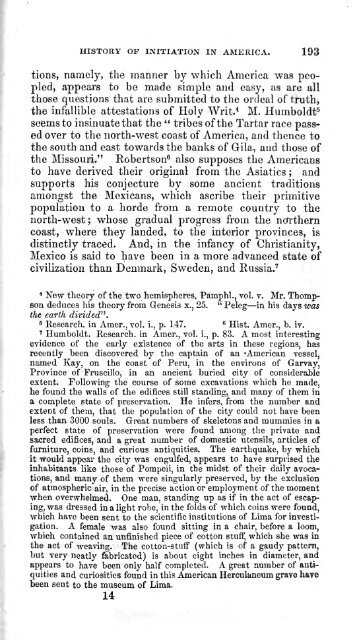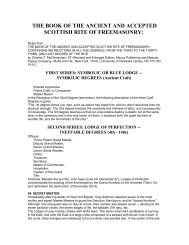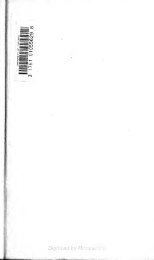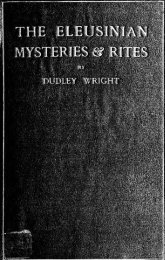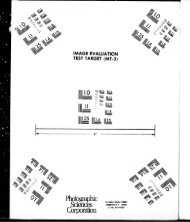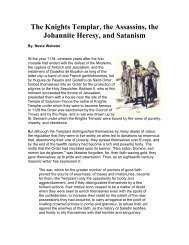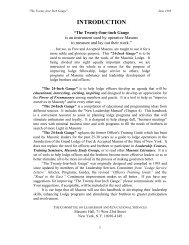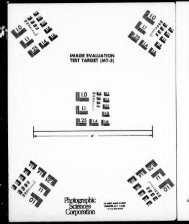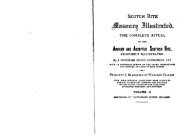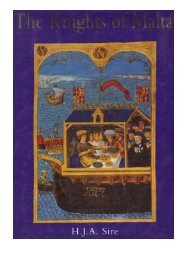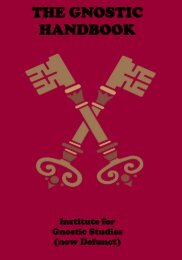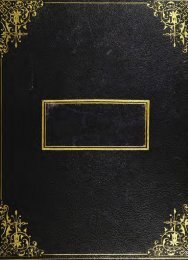The History of Initiation - The Masonic Trowel
The History of Initiation - The Masonic Trowel
The History of Initiation - The Masonic Trowel
You also want an ePaper? Increase the reach of your titles
YUMPU automatically turns print PDFs into web optimized ePapers that Google loves.
HISTORY OF INITIATION IN AMERICA. 193<br />
tions, namely, the manner by which America was peo-<br />
pled, appears to be made simple and easy,<br />
;is ;ire all<br />
those questions that are submitted to the ordeal <strong>of</strong> truth,<br />
the infallible attestations <strong>of</strong> Holy Writ. 4 M. Humboldt 5<br />
seems to insinuate that the " tribes <strong>of</strong> the Tartar race passed<br />
over to the north-west coast <strong>of</strong> America, and thence to<br />
the south and east towards the banks <strong>of</strong> Gila, and those <strong>of</strong><br />
the Missouri." Robertson 6 also supposes the Americans<br />
to have derived their original from the Asiatics ; and<br />
supports his conjecture by some ancient traditions<br />
amongst the Mexicans, which ascribe their primitive<br />
population to a horde from a remote country to the<br />
north-west; whose gradual progress from the northern<br />
coast, where they landed, to the interior provinces, is<br />
distinctly traced. And, in the infancy <strong>of</strong> Christianity,<br />
Mexico is said to have been in a more advanced state <strong>of</strong><br />
civilization than Denmark, Sweden, and Russia. 7<br />
4 New theory <strong>of</strong> the two hemispheres. Pamphl., vol. v. Mr. Thompson<br />
deduces his theory from Genesis<br />
"<br />
x. 25.<br />
3 Peleg in his days was<br />
the earth divided".<br />
5 6 Research, in Amer., vol. i., p. 147. Hist. Amer., b. iv.<br />
7 Humboldt. Research, in Amer., vol. i., p. 83. A most interesting<br />
evidence <strong>of</strong> the early existence <strong>of</strong> the arts in these regions, has<br />
recently been discovered by the captain <strong>of</strong> an 'American vessel,<br />
named Kay, on the coast <strong>of</strong> Peru, in the environs <strong>of</strong> Garvay,<br />
Province <strong>of</strong> Fruscillo, in an ancient buried city <strong>of</strong> considerable<br />
extent. Following the course <strong>of</strong> some excavations which he made,<br />
he found the walls <strong>of</strong> the edifices still standing, and many <strong>of</strong> them in<br />
a complete state <strong>of</strong> preservation. He infers, from the number and<br />
extent <strong>of</strong> them, that the population <strong>of</strong> the city could not have been<br />
less than 3000 souls. Great numbers <strong>of</strong> skeletons and mummies in a<br />
perfect state <strong>of</strong> preservation were found among the private and<br />
sacred edifices, and a great number <strong>of</strong> domestic utensils, articles <strong>of</strong><br />
furniture, coins, and curious antiquities. <strong>The</strong> earthquake, by which<br />
it would appear the city was engulfed, appears to have surprised the<br />
inhabitants like those <strong>of</strong> Pompeii, in the midst <strong>of</strong> their daily avocations,<br />
and many <strong>of</strong> them were singularly preserved, by the exclusion<br />
<strong>of</strong> atmospheric air, in the precise action or employment <strong>of</strong> the moment<br />
when overwhelmed. One man, standing up as if in the act <strong>of</strong> escaping,<br />
was dressed in alight robe, in the folds <strong>of</strong> which coins were found,<br />
which have been sent to the scientific institutions <strong>of</strong> Lima for investi-<br />
gation. A female was also found sitting in a chair, before a loom,<br />
which contained an unfinished piece <strong>of</strong> cotton stuff, which she was in<br />
the act <strong>of</strong> weaving. <strong>The</strong> cotton-stuff (which is <strong>of</strong> a gaudy pattern,<br />
but very neatly fabricated) is about eight inches in diameter, and<br />
appears to have been only half completed. A great number <strong>of</strong> antiquities<br />
and curiosities found in this American Herculuneum grave have<br />
been sent to the museum <strong>of</strong> Lima.<br />
14


